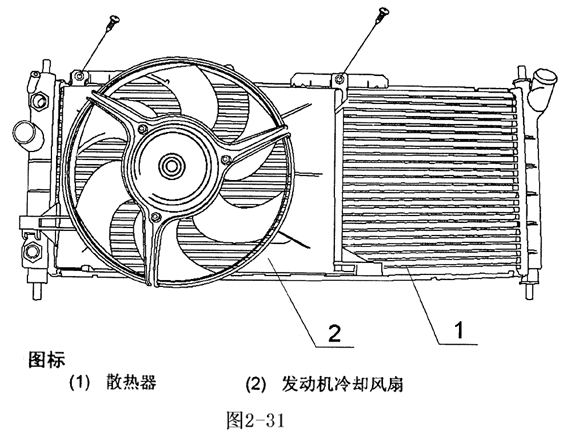2025年10月31日
TE2025年10月30日
罗克韦尔2025年10月24日
采埃孚2025年10月24日
兆易创新2025年10月24日
欣旺达2025年10月27日
魏德米勒
2025年10月22日
倍福
2025年10月16日
罗克韦尔
2025年10月16日
明珞装备
2025年10月11日
EMAG
2025年10月31日
海克斯康
2025年10月24日
Melexis
2025年10月24日
倍加福
2025年10月23日
科尔摩根
2025年10月23日
海康机器人
Although gasoline engines have improved a lot, they are still not very efficient at turning chemical energy into mechanical power. Most of the engergy in the gasolint (perhaps 70%) is converted into heat, and it is the job of the cooling system to take care of that heat. In fact, the cooling system on a car driving down the freeway dissipates enough heat to heat two average-sized houses! The primary job of the cooling system is to keep the engine from overheating by transferring this heat to the air, but the cooling system also has several other important jobs.
The engine in your car runs best at a fairly high temperature. When the engine is cold, components wear out faster, and the engine is less efficient and emits more pollution. So another important job of the cooling system is to allow the engine to heat up as quickly as possible, and then to keep the engine at a constant temperature.
In this article, we’ll learn about the parts of a car cooling system and how they work. First, let’s look at some basics.
The Basics
Inside your car’s engine, fuel is constantly burning. A lot of the heat from this combustion goes right out the exhaust system, but some of it soaks into the engine, heating it up. The engine runs best when its coolant is about 200 degrees Fahrenheit (93 degrees Celsius). At this temperature:
l The combustion chamber is hot enough to completely vaporize the fuel, providing better combustion and reducing emissions.
l The oil used to lubricate the engine has a lower viscosity (it is thinner), so the engine parts move more freely and the engine wastes less power moving its own components around.
l Metal parts wear less.
There are two types of cooling systems found on cars: liquid-cooled and air-cooled.
Liquid Cooling
The cooling system on liquid-cooled cars circulates a fluid through pipes and passageways in the engine. As this liquid passes through the hot engine it absorbs heat, cooling the engine. After the fluid leaves the engine, it passes through a heat exchanger, or radiator, which transfers the heat from the fluid to the air blowing through the exchanger.
Air Cooling
Some older cars, and very few modern cars, are air-cooled. Instead of circulating fluid through the engine, the engine block is covered in aluminum fins that conduct the heat away from the cylinder. Apowerful fan forces air over these fins, which cools the engine by transferring the heat to the air.
Since most cars are liquid-cooled, we will focus on that system in this article.
Water Pump
The water pump is a simple centrifugal pump driven by a belt connected to the crankshaft of the engine. The pump circulates fluid whenever the engine is running.
The water pump uses centrifugal force to send fluid to the outside while it spins, causing fluid to be drawn from the center continuously. The inlet to the pump is located near the center so that fluid returning from the radiator hits the pump vanes. The pump vanes fling the fluid to the outside of the pump, where it can enter the engine.
The fluid leaving the pump flows first through the engine block and cylinder head, then into the radiator and finally back to the pump.
Radiator
A radiator is a type of heat exchanger. It is designed to transfer heat from the hot coolant that flows through it to the air blown through it by the fan.
Most modern cars use aluminum radiators. These radiators are made by brazing thin aluminum fins to flattened aluminum tubes. The coolant flows from the inlet to the outlet through many tubes mounted in a parallel arrangement. The fins conduct the heat from the tubes and transfer it to the air flowing through the radiator.
Thermostat
The thermostat’s main job is to allow the engine to heat up quickly, and then to keep the engine at a constant temperature. It does this by regulating the amount of water that goes through the radiator. At low temperatures, the outlet to the radiator is completely blocked-all of the coolant is recirculated back through the engine.
Once the temperature of the coolatn rises to between 180 and 195 F(82-91 C), the thermostat starts to open, allowing fluid to flow throught the radiator. By the time the coolant reaches 200 to 218 F (93-103 C), the thermostat is open all the way.
Fan
Like the thermostat, the cooling fan has to be controlled so that it allows the engine to maintain a constant temperature.
Front-wheel drive cars have electric fans because the engine is usually mounted transversely, meaning the output of the engine points toward the side of the car. The fans are controlled either with a thermostatic swithch or by the engine computer, and they turn on when the temperature of the coolant goes above a set point. They turn back off when the temperature drops below that point.
Rear-wheel drive cars with longitudinal engines usually have engine-driven cooling fans. These fans have a thermostatically controlled viscous clutch. This clutch is positioned at the hub of the fan, in the airflow coming through the radiator. This special viscous clutch is much like the viscous coupling sometimes found in all-wheel drive cars.
参考译文:
虽然汽油机发动机改进了许多,但是在化学能转变为机械能量的过程中,发动机的效率仍然不高。发动机的大部分能量变成了热能,而冷却系统的任务就是处理这些热能。事实上,冷却系统把热量散发时将热量分成了两部分,冷却系统的首要任务是通过将热传递给大气层以阻止发动机过热,冷却系统还有一些其他的任务。
你的汽车在很高的温度下运行良好。当发动机未预热在冷的状态时,发动机的零件磨损会更快,而且发动机的效率会降低,尾气的排放会造成更严重的污染。因此冷却系统还有一个重要任务,就是让发动机迅速预热,然后就让发动机保持在一个恒定的温度。
本文就是介绍冷却系统的零部件及工作原理。首先来了解一些基本知识。


基本知识
在发动机内,燃油在不停地燃烧。很多的热量从燃烧室散发出来,直接进入废气排气系统,一部分热量进入了发动机去预热发动机。在华氏200度时,发动机运转到了最佳。在这个温度下:
燃烧室温度不断上升,使燃油变成了气体,改善了燃烧也降低了排放。
发动机的润滑油的粘度较低,便于发动机运转自如,减少了发动机的损耗。
减少金属零件的磨损。冷却系统有两种:风冷和水冷。
水冷
水冷系统在发动机中的管路和通道中循环流动。当液体流过发热的发动机时,就吸收了大量热量。当液体流出发动机时,通过热交换器或散热器,将液体变为气体吹走。
风冷
有些老式汽车和极少数现代汽车采用风冷系统,发动机不是用液体循环冷却,而是在发动机上装铝制散热片,使热量从气缸排出机体外,在散热片上装了大功率的风扇,把热风吹走,使发动机冷却。
因为大部分的汽车采用的水冷,所以我们就主要讨论水冷系统。
水泵
水泵就是一个简单的离心泵,用皮带连接发动机上的曲轴。发动机无论何时运转水泵都能循环起来。
当水泵转动时,其离心力把液体甩出来,从而就不断地从中心吸水。泵的入口靠近中心,因而能使从散热器回来的液体流到水泵的叶片。叶片将水甩出,进入发动机。
液体从水泵流出进入发动机箱和气缸缸体,然后进入散热器最后回到水泵。
散热器
散热器是热交换机的一种。散热器将发热的冷却液的热量传递给大气,然后用风扇吹入大气。大多数车使用铝散热器。散热器由薄铝片通过铜焊焊接在扁铝管上。冷却液通过许多平行管流到出口。散热片将热量从水管传递到经过散热器的空气。
节温器
节温器的主要任务是使发动机迅速预热,然后使发动机保持在一个恒定的温度。这是通过调节流过散热器的水流量来控制的。在低温时,散热器的出口完全被堵住——所有的冷却液在发动机内来回流动。
一旦冷却液的温度上升至华氏180至195度时,节温器开始打开,允许机油流至散热器。而冷却液的温度升至200至218,节温器全开。
风扇
就像节温器一样,风扇能使发动机保持在一个稳定的温度。
前轮驱动的汽车采用电风扇是因为发动机横置意味着发动机的输出指向汽车的侧面。风扇要么由恒温开个控制,要么由发动机芯片控制,当冷却液温度高过了设定值时,风扇开始工作。反之,则关闭风扇。
发动机纵置的后轮驱动汽车由发动机驱动电风扇。这些风扇有一个恒温控制的粘液离合器。粘液离合器安装在风扇的中心,浸在来自散热器的气流里。这种特殊的粘液离合器就像四轮驱动汽车里的粘性联轴器。